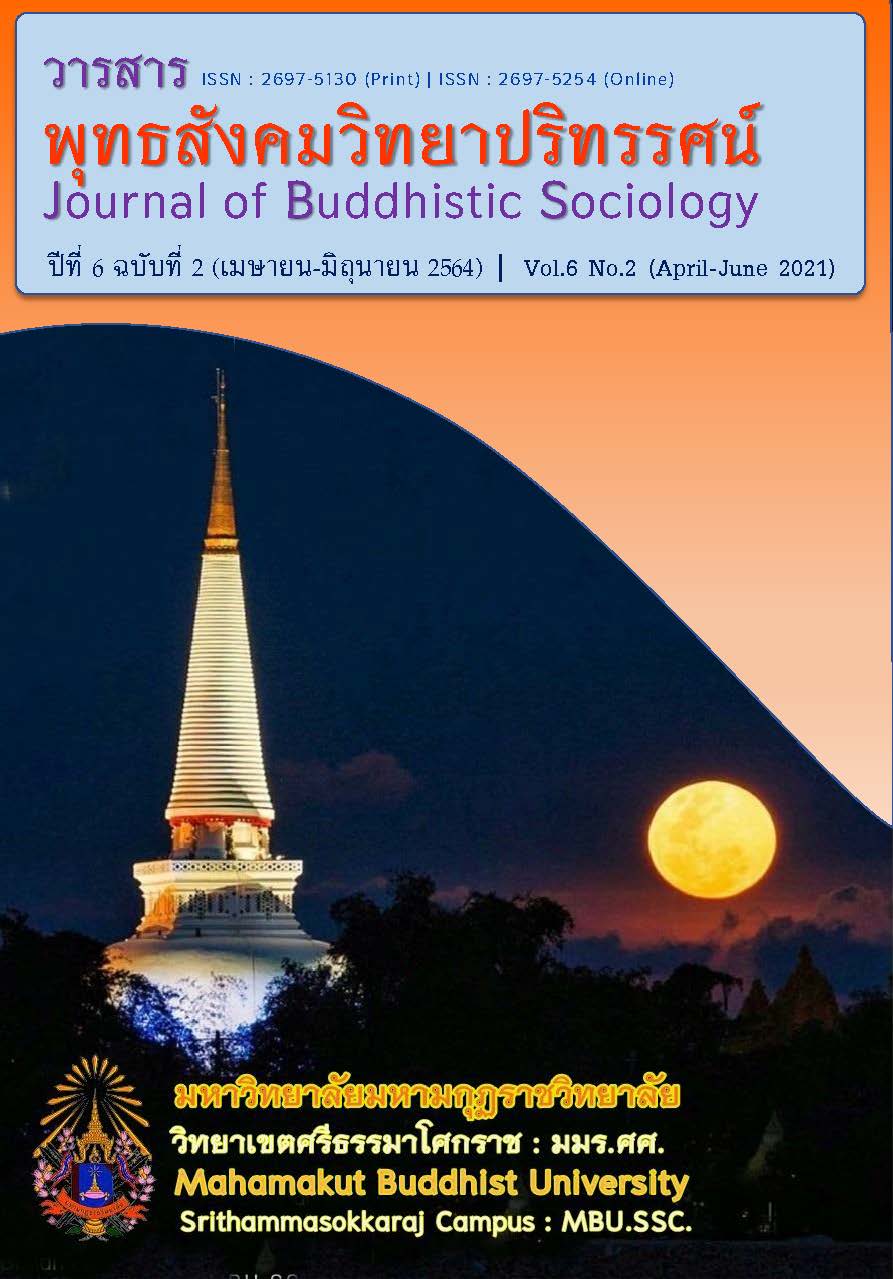AN ACADEMIC ADMINISTRATION MODEL FOR THE ADMINISTRATORS OF PHRAPARIYATTIDHAMMA SCHOOLS IN GENERAL EDUCATION DEPARTMENT
Main Article Content
Abstract
The purposes of this research were as follows; 1. to study the components of the academic administration model for the administrators of Phrapariyattidhamma schools in general education department 2. to create the academic administration model for the administrators of Phrapariyattidhamma schools in general education department and 3. to evaluate and confirm the academic administration model for the administrators of Phrapariyattidhamma schools in the general education department. This was mixed method research. The sample group consisted of Phrapariyattidhamma schools, deputy directors of the schools and teachers, 696 people in total. The research instrument was the questionnaire with 5 rating scales having IOC 0.6-1.0, discriminatory power 0.34-0.85 and reliability at 0.97. Frequency, percentage, mean, standard deviation, exploratory factor analysis (EFA), and confirmatory factor analysis (CFA) were used for data analysis by using statistical package software.
The research found that:
1.The components of an academic administration model for the administrators of Phrapariyattidhamma schools in general education department studied from concepts, theories, documents, academic books and interviews of the specialists and experts were composed of 19 drafts of components and 105 variables.
2. The results of the creation of the academic administration model for the administrators of Phrapariyattidhamma schools in the general education department gained from EFA had 5 main components as follows; 1) Academic planning 2) Learning management 3) Operations 4) Educational participation and 5) Academic monitoring. The results from CFA indicated that the highest value of the academic administration model for the administrators of Phrapariyattidhamma schools in the general education department was on Learning management, followed by Academic monitoring, Operation, Educational participation and Academic planning, respectively. There was a chi-square value = 11.311, DF = 9, P-value = .255, GFI = .998, AGFI = .964, and RMSER = .019. This result indicated that the model was consistent with the empirical data.
3. The evaluation and confirmation of the model from the specialists and experts in its propriety, accuracy, feasibility, and utility was at 4.53 (=4.53) passing the criteria of evaluation and confirmation set by the researcher that must be higher than 3.51. This could conclude that the model was approved by the specialists and experts.
Article Details
References
กองพุทธศาสนศึกษา สำนักงานพระพุทธศาสนาแห่งชาติ. (2558). แผนยุทธศาสตร์ และแผนการปฏิบัติการพัฒนาการศึกษา โรงเรียนพระปริยัติธรรม แผนกสามัญศึกษา (พ.ศ. 2553 - พ.ศ. 2562). กรุงเทพมหานคร: โรงพิมพ์สำนักงานพระพุทธศาสนาแห่งชาติ.
พระพิทักษ์ บุญปัน. (2560). รูปแบบการบริหารงานวิชาการโรงเรียนพระปริยัติธรรม แผนกบาลี ในเขตจังหวัดหนองคาย. ใน วิทยานิพนธ์ศึกษาศาสตรดุษฎีบัณฑิต สาขาวิชาการบริหารการศึกษา. มหาวิทยาลัยปทุมธานี.
พระมหาสุพจน์ สุเมโธ (พานทอง). (2554). พรหมวิหาร 4 แนวคิดเชิงบูรณาการในการบริหารงานบุคคลในสถานศึกษา. ใน วิทยานิพนธ์พุทธศาสตรดุษฎีบัณฑิต สาขาพุทธบริหารการศึกษา. มหาวิทยาลัยมหาจุฬาลงกรณราชวิทยาลัย.
ภารดี อนันต์นาวี. (2557). หลักการ แนวคิด ทฤษฎีทางการบริหารการศึกษา. ชลบุรี: มนตรี.
มลวิภา สิขเรศ. (2559). รูปแบบการบริหารงานวิชาการเชิงพุทธบูรณการของผู้บริหารสถานศึกษาโรงเรียนมัธยมศึกษา จังหวัดสมุทรปราการ. ใน วิทยานิพนธ์พุทธศาสตรดุษฎีบัณฑิต สาขาวิชาพุทธบริหารการศึกษา. มหาวิทยาลัยมหาจุฬาลงกรณ์ราชวิทยาลัย.
รุ่งทิวา จันทน์วัฒนวงษ์. (2557). เอกสารประกอบการสอนวิชาการพัฒนาหลักสูตร (Curriculum Development). อุดรธานี: คณะครุศาสตร์ มหาวิทยาลัยราชภัฏอุดรธานี.
สำนักงานคณะกรรมการการศึกษาขั้นพื้นฐาน. (2552). คู่มือการปฏิบัติงานข้าราชการครู. กรุงเทพมหานคร: สำนักงานคณะกรรมการการศึกษาขั้นพื้นฐาน.
Kerry, Rice. (2009). Priorities in K-12 Distance Education : A Delphi Study Examining Multiple Perspectives on Policy. Journal Practice and Research. Educational Technology & Society, 12(3), 163-170.


